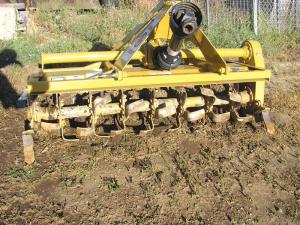2020 - Volume #44, Issue #5, Page #36
[ Sample Stories From This Issue | List of All Stories In This Issue | Print this story
| Read this issue]
“Skid Tines” Make Tiller Dig Deeper
 |
“We had an older tiller that came without skids, and it sank into the soil more than tillers with skids,” explains Siegrist. “We like the added tillage, but over the course of 5 years, our abrasive soils wore right through the gearbox.”
When Siegrist bought a new tiller for his produce business, he wanted the deeper tillage without the wear. His added tines do the job. He suspects the angled tines also provide some pull or suction on the tiller.
“The tines are cut down from salvaged field cultivator teeth,” says Siegrist. “They were originally about 12 to 14 in. long, and I cut them in half.”
He created a mount by welding pieces of angle iron to one end of each tine and drilling 2 holes in the face of the angle iron perpendicular to the end of the tine.
“I drilled 3 holes with the same spacing as the 2 on the tines in the upturned portion of the skids,” says Siegrist. “Initially I mounted the tine to the first 2 holes, but the tiller didn’t go in as deep as I wanted.”
Siegrist moved the tines back, bolting them to the second and third holes. Because of the angle of the skids, this gave the tines a deeper bite, loosening the soil to a little more depth and letting the skids settle deeper.
“With a project like this, there is no engineer to tell you what to do, so you just try things,” says Siegrist. “I knew that with the skids angled up, I wanted enough length that the tines would be pointing down at an angle.”
Siegrist also wanted the tines angled in toward the path of the tiller. “I didn’t want to create furrows to the side of the tilled bed,” he says.
Sizing and placement of the tines has been just what Siegrist had hoped for. The tiller now goes deeper than its original 2 to 3 in., but not deep enough to bring up a lot of rocks.
“It is perfect for our potato beds,” says Siegrist. “We make a second pass, and it digs down until the bar across the front of the tiller is almost hitting the dirt. It takes a little more power, but really mixes up the dirt.”
Siegrist admits that if a field had heavy residue, the tines might be a problem. In that case he would opt for a disk blade to cut and loosen. As they disk fields in the fall, there is not much residue when spring tilling.
Contact: FARM SHOW Followup, Marcus Siegrist, 5229 S. Swenson Rd., Deer Park, Wash. 99006 (ph 509 276 6758 or 509 262-8765; marcus@siegristproduce.com).

Click here to download page story appeared in.

Click here to read entire issue
To read the rest of this story, download this issue below or click here to register with your account number.




